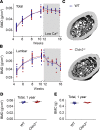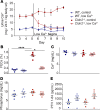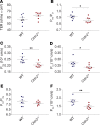Claudin-2 deficiency associates with hypercalciuria in mice and human kidney stone disease
- PMID: 32149733
- PMCID: PMC7108907
- DOI: 10.1172/JCI127750
Claudin-2 deficiency associates with hypercalciuria in mice and human kidney stone disease
Abstract
The major risk factor for kidney stone disease is idiopathic hypercalciuria. Recent evidence implicates a role for defective calcium reabsorption in the renal proximal tubule. We hypothesized that claudin-2, a paracellular cation channel protein, mediates proximal tubule calcium reabsorption. We found that claudin-2-null mice have hypercalciuria due to a primary defect in renal tubule calcium transport and papillary nephrocalcinosis that resembles the intratubular plugs in kidney stone formers. Our findings suggest that a proximal tubule defect in calcium reabsorption predisposes to papillary calcification, providing support for the vas washdown hypothesis. Claudin-2-null mice were also found to have increased net intestinal calcium absorption, but reduced paracellular calcium permeability in the colon, suggesting that this was due to reduced intestinal calcium secretion. Common genetic variants in the claudin-2 gene were associated with decreased tissue expression of claudin-2 and increased risk of kidney stones in 2 large population-based studies. Finally, we describe a family in which males with a rare missense variant in claudin-2 have marked hypercalciuria and kidney stone disease. Our findings indicate that claudin-2 is a key regulator of calcium excretion and a potential target for therapies to prevent kidney stones.
Keywords: Calcium; Cell Biology; Epithelial transport of ions and water; Nephrology; Transport.
Conflict of interest statement
Figures







Comment in
-
Claudin 2: role in hypercalciuria and kidney stone disease.Nat Rev Nephrol. 2020 May;16(5):252. doi: 10.1038/s41581-020-0273-x. Nat Rev Nephrol. 2020. PMID: 32210380 No abstract available.
-
Claudin 2 and hypercalciuria - of mice and men.Nat Rev Urol. 2020 May;17(5):255. doi: 10.1038/s41585-020-0318-8. Nat Rev Urol. 2020. PMID: 32273584 No abstract available.
-
Re: Claudin-2 Deficiency Associates with Hypercalciuria in Mice and Human Kidney Stone Disease.J Urol. 2020 Aug;204(2):379-380. doi: 10.1097/JU.0000000000001112. Epub 2020 May 12. J Urol. 2020. PMID: 32396431 No abstract available.
-
Genetic variation in claudin-2, hypercalciuria, and kidney stones.Kidney Int. 2020 Nov;98(5):1076-1078. doi: 10.1016/j.kint.2020.05.055. Epub 2020 Jul 10. Kidney Int. 2020. PMID: 32653401 No abstract available.
-
Re: Claudin-2 Deficiency Associates with Hypercalciuria in Mice and Human Kidney Stone Disease.J Urol. 2020 Oct;204(4):882-883. doi: 10.1097/JU.0000000000001222.02. Epub 2020 Jul 27. J Urol. 2020. PMID: 32716223 No abstract available.
Similar articles
-
Kidney stones, hypercalciuria, and recent insights into proximal tubule calcium reabsorption.Curr Opin Nephrol Hypertens. 2023 Jul 1;32(4):359-365. doi: 10.1097/MNH.0000000000000892. Epub 2023 Apr 19. Curr Opin Nephrol Hypertens. 2023. PMID: 37074688 Review.
-
Role of claudins in idiopathic hypercalciuria and renal lithiasis.Int Urol Nephrol. 2022 Sep;54(9):2197-2204. doi: 10.1007/s11255-022-03119-2. Epub 2022 Jan 27. Int Urol Nephrol. 2022. PMID: 35084652 Review.
-
Paracellular calcium transport in the proximal tubule and the formation of kidney stones.Am J Physiol Renal Physiol. 2019 May 1;316(5):F966-F969. doi: 10.1152/ajprenal.00519.2018. Epub 2019 Mar 6. Am J Physiol Renal Physiol. 2019. PMID: 30838875 Free PMC article. Review.
-
Claudin-12 Knockout Mice Demonstrate Reduced Proximal Tubule Calcium Permeability.Int J Mol Sci. 2020 Mar 18;21(6):2074. doi: 10.3390/ijms21062074. Int J Mol Sci. 2020. PMID: 32197346 Free PMC article.
-
Claudins and nephrolithiasis.Curr Opin Nephrol Hypertens. 2018 Jul;27(4):268-276. doi: 10.1097/MNH.0000000000000426. Curr Opin Nephrol Hypertens. 2018. PMID: 29782346 Review.
Cited by
-
Peroxisome Proliferator-Activated Receptor Alpha Stimulation Preserves Renal Tight Junction Components in a Rat Model of Early-Stage Diabetic Nephropathy.Int J Mol Sci. 2024 Dec 7;25(23):13152. doi: 10.3390/ijms252313152. Int J Mol Sci. 2024. PMID: 39684861 Free PMC article.
-
Functional analysis reveals calcium-sensing receptor gene regulating cell-cell junction in renal tubular epithelial cells.Int Urol Nephrol. 2024 Jul;56(7):2165-2177. doi: 10.1007/s11255-024-03948-3. Epub 2024 Feb 19. Int Urol Nephrol. 2024. PMID: 38372840
-
Mutations in CLDN2 Are Not a Common Cause of Pediatric Idiopathic Hypercalciuria in Canada.Can J Kidney Health Dis. 2022 May 19;9:20543581221098782. doi: 10.1177/20543581221098782. eCollection 2022. Can J Kidney Health Dis. 2022. PMID: 35615069 Free PMC article.
-
Context-Dependent Roles of Claudins in Tumorigenesis.Front Oncol. 2021 Jul 20;11:676781. doi: 10.3389/fonc.2021.676781. eCollection 2021. Front Oncol. 2021. PMID: 34354941 Free PMC article. Review.
-
Tight junction and kidney stone disease.Tissue Barriers. 2024 Jan 2;12(1):2210051. doi: 10.1080/21688370.2023.2210051. Epub 2023 May 10. Tissue Barriers. 2024. PMID: 37162265 Free PMC article. Review.
References
Publication types
MeSH terms
Substances
Grants and funding
LinkOut - more resources
Full Text Sources
Other Literature Sources
Molecular Biology Databases

